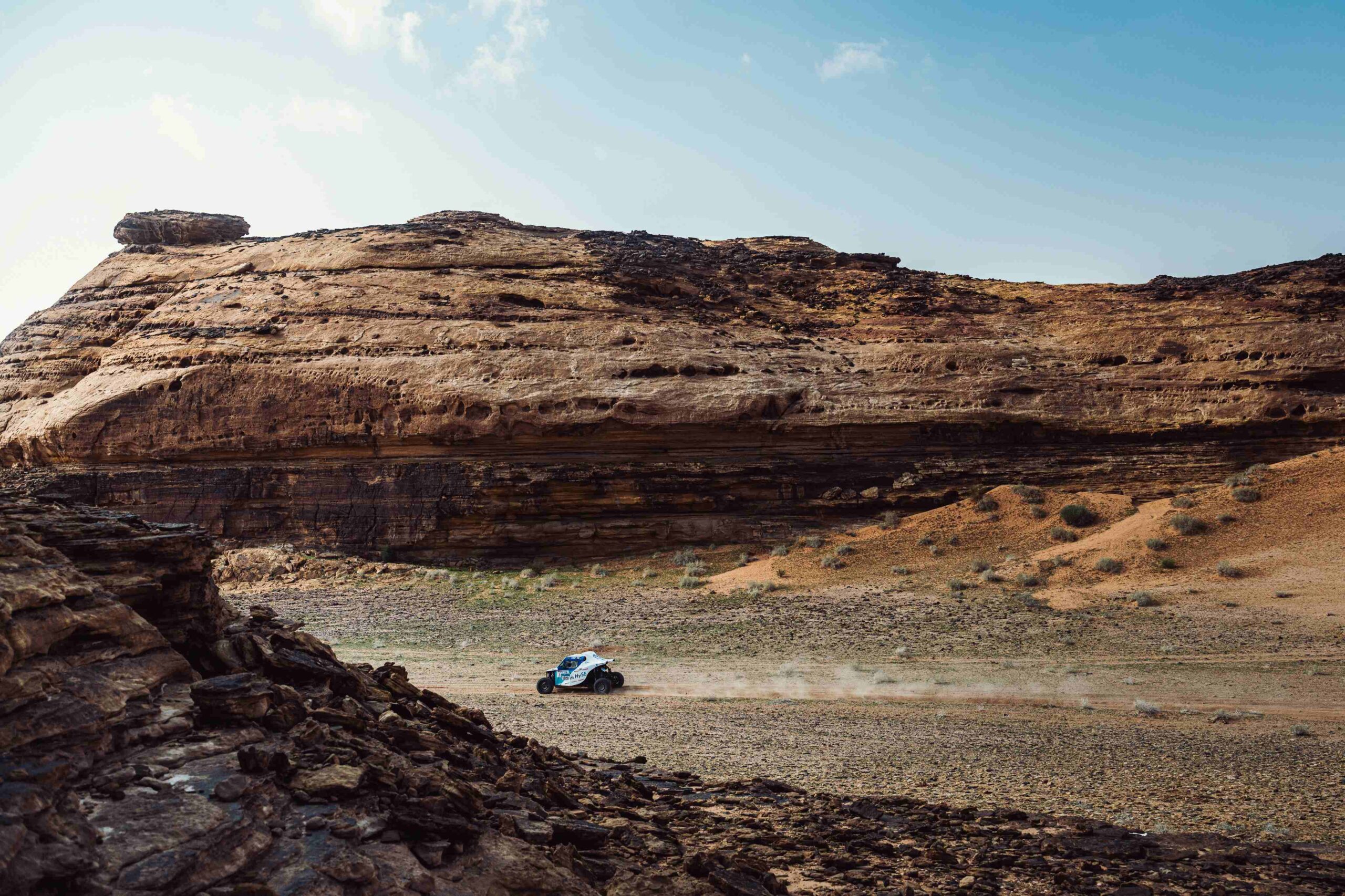Media Information
Hydrogen Small mobility & Engine technology (HySE)
46th Dakar Rally
January 5th-19th, 2024
HYDROGEN-POWERED HYSE-X1 POWERS THROUGH THE AL-ULA LOOP STAGE AND REMAINS ON TRACK TO FINISH THE 46TH DAKAR RALLY
Al-ULA (SAUDI ARABIA) – Wednesday, January 17: The ground-breaking hydrogen-powered HySE-X1 is now two stages away from fulfilling the objective of completing the 46th Dakar Rally.
The HySE (Hydrogen Small mobility & Engine technology) has been entered in the new modern Dakar class (Mission 1000). This is an integral part of the Dakar Future Programme to encourage manufacturers to develop next-generation carbon-neutral powertrain technologies.
The crew of American driver Jamie Campbell and Argentinean co-driver Bruno Jacomy completed a sandy stage of 61km through beautiful desert terrain near the city of Al-Ula on Wednesday and are confident that they can now press on over the remaining two days and reach the finish in Yanbu on Friday.
Quotes after Stage 10 on Wednesday, January 17th
Jamie Campbell, Driver:
“The stage was sandy and we had to conserve fuel at the beginning. The landscape was beautiful, especially coming in to the stage finish. We really got to open up the car here, 95 to 100km/h. The HySE hydrogen engine is running perfectly.”
Bruno Jacomy, Co-driver:
“Stage 10 was a good one. Today we make 61km in full sand between valleys and soft sand and a lot of ruts. Like every day, we had some navigation. It was a really good day. I think we managed the consumption well. In the first half we conserved too much the hydrogen and then, on the last part, we pushed a little bit and it was a really good stage for the team. We had a good finish. The last 10km we were full gas; the engine was really good.”
Keita Nakanishi, Project Leader of HySE Dakar Project:
“Stage 10 was set near Al-Ula, where the HySE-X1 ran the Prologue (January 5th). Originally the distance was 85km but the road surface was soft sand and it was expected that it would be extremely challenging for fuel consumption. However, on this stage, we had the option to take a shortcut along the way, so we talked to Jamie and Bruno about trying short-distance, high-load driving instead of long-distance driving. Since the stage was 61km long, they didn’t have to worry about fuel consumption and they seemed to be able to run comfortably, especially on flat terrain. I will analyse the data from now on though. I think we are getting good results for the remaining two stages.”
The modern Dakar class entrants tackled a shortened stage of 94km between Ha’il and the picturesque city of Al-Ula on Tuesday. That said, the special took place entirely on a sandy piste with numerous tracks and that affected fuel consumption for the second time. The HySe-X1 needed external assistance to complete the middle section of the special before reaching the stage finish on its own depleted hydrogen reserves.
Quotes after Stage 9 on Tuesday, January 16th
Jamie Campbell, Driver:
“Stage nine was tough with some soft sand and it dragged the car down quite a bit. We did the best we could and got about 74km. It was almost 100% sand. We did our best to get the car as far as we could and we did pretty good. We still have to manage the next stage. That will be all sand as well.”
Bruno Jacomy, Co-driver:
“Today was a tough day in the office. We made like 74km in the soft sand. It was not really soft but there were a lot of traces (tracks) to make it soft. That was the problem and that affected the fuel consumption of our car. We tried to manage to the end. Another day with consumption problems but we are looking forward for the next one.”
Keita Nakanishi, Project Leader of HySE Dakar Project:
“The distance of stage nine had been shortened to 94km when the course was announced on Monday night, so I was relieved as it looked like there might be a slight chance of completing it. On the other hand, we had heard the surface was sandy, so I was also a little concerned. My bad feeling was justified: the resistance of the sandy surface caused the fuel consumption to deteriorate, making it difficult to complete the stage. Jamie and Bruno kept their wits about them and were towed by the organisers’ truck in the middle of the stage and were able to run to the finish line on their own.
“This is the second stop after the day before yesterday due to a fuel shortage. I would propose HySE to research to significantly increase combustion efficiency. There will be a series of short stages from Wednesday until the final day, so I’d like Jamie and Bruno to enjoy the full performance of the hydrogen engine.”
The HySE-X1 SSV is a joint project between the Japanese automotive manufacturers – Honda, Kawasaki, Suzuki, Toyota and Yamaha – and utilises a chassis built by Overdrive Racing.
The chassis has been modified to accommodate three hydrogen fuel tanks and fuel supply system powering a 998cc, four-stroke supercharged motorcycle engine being used in research and development.
Tomorrow (Thursday), teams head from Al-Ula to the Red Sea city of Yanbu and Mission 1000 entrants will tackle a challenging stage of 69km. That precedes Friday’s final timed test of 46km and the ceremonial finish adjacent to the Red Sea in the evening.
Ends


